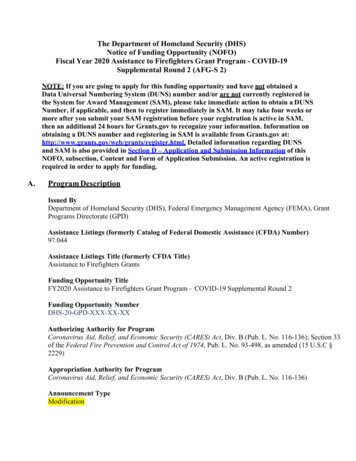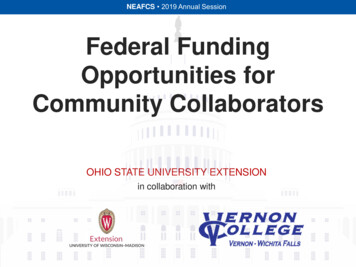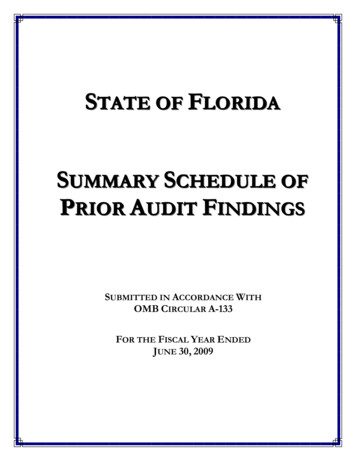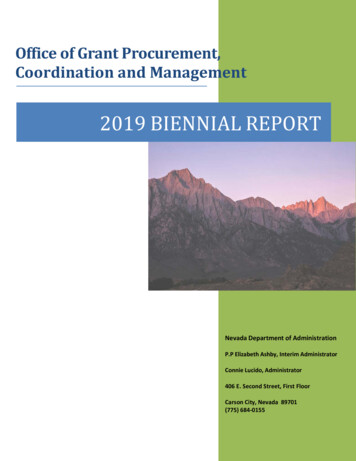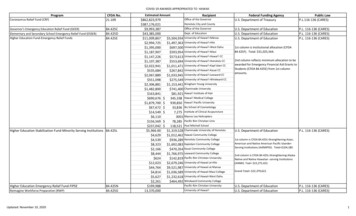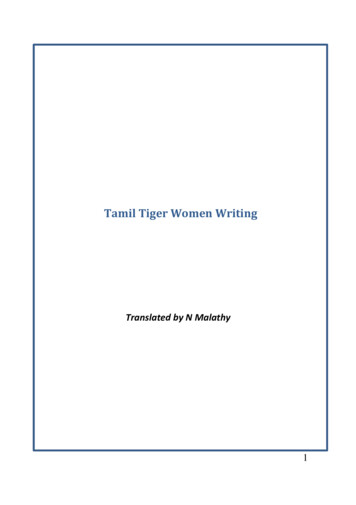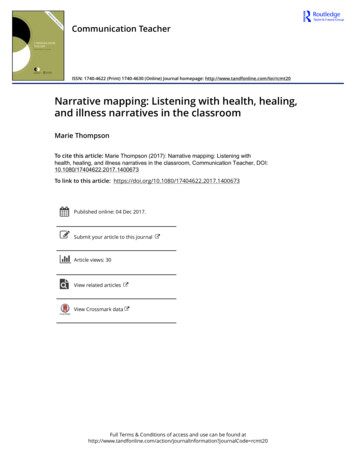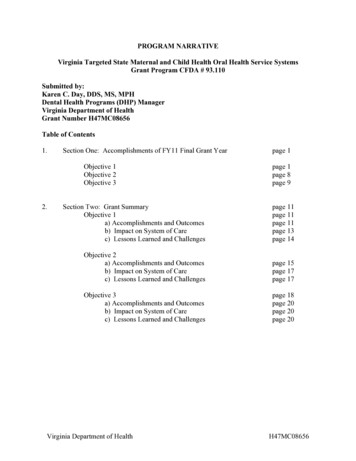
Transcription
PROGRAM NARRATIVEVirginia Targeted State Maternal and Child Health Oral Health Service SystemsGrant Program CFDA # 93.110Submitted by:Karen C. Day, DDS, MS, MPHDental Health Programs (DHP) ManagerVirginia Department of HealthGrant Number H47MC08656Table of Contents1.Section One: Accomplishments of FY11 Final Grant YearObjective 1Objective 2Objective 32.page 1page 1page 8page 9Section Two: Grant SummaryObjective 1a) Accomplishments and Outcomesb) Impact on System of Carec) Lessons Learned and Challengespage 11page 11page 11page 13page 14Objective 2a) Accomplishments and Outcomesb) Impact on System of Carec) Lessons Learned and Challengespage 15page 17page 17Objective 3a) Accomplishments and Outcomesb) Impact on System of Carec) Lessons Learned and Challengespage 18page 20page 20page 20Virginia Department of HealthH47MC08656
I. SECTION ONE: ACCOMPLISHMENTS OF FY11 FINAL GRANT YEAROBJECTIVE 1By 2011, integrate dental visits for one-year old childreninto existing systems that currently serve high-riskchildren.Activity 1By 2011, extensively promote the conceptof a dental home by working with theVirginal Chapter of the AmericanAcademy of Pediatrics (AAP) to increaseawareness by medical providers who carefor infants and toddlers.Activity 2By 2011, get legislative approval for all sixMedicaid Health MaintenanceOrganizations (HMOs) to reimbursemedical providers for oral screenings andfluoride varnish application by workingwith the Department of Medical AssistanceServices (DMAS) and the Virginia Chapterof the AAP.Activity 3By 2011, work with the SpecialSupplemental Nutrition Program forWomen, Infants and Children (WIC) in 11target health districts (Chesterfield, Crater,Hampton, Hanover, Henrico, Piedmont,Peninsula, Rappahannock, Richmond City,Thomas Jefferson, Three Rivers) toestablish a system for providing dentalvisits for 12,179 infants and 19,314 youngchildren in WIC, targeting one-fourth oflocalities per year starting in 2008.Virginia Department of Health1Accomplishments in FY 2011 (Grant Year 4)Collaborated with the Virginia Chapter of the AAP to publish anarticle in the Spring 2011 Virginia Pediatrics newsletter regardingearly childhood caries, the importance of incorporating oralpreventive services in the medical setting, and referring children to alocal dental home. Distribution extended to approximately 1,200pediatricians.Effective September 2008, all Medicaid HMOs reimburse medicalproviders for fluoride varnish applications for children between theage of six months and three years. There is currently noreimbursement for medical providers who provide oral screenings ororal health anticipatory guidance.In FY 11, DHP maintained preventive services in 10 of 11 targetedhealth districts (Chesterfield, Crater, Hanover, Henrico, Piedmont,Peninsula, Rappahannock, Richmond City, Thomas Jefferson, andThree Rivers). The program ended in Hampton due to unsuccessfulinitial implementation. With supplemental grant funding, DHPcontinued to support the Lord Fairfax district and piloted threeadditional districts (Eastern Shore, Norfolk, and Chesapeake). Finalgrant activity reports have been written for each district tosummarize services provided and make recommendations regardingoptions for sustaining services. Meetings with key district staff arebeing scheduled; one district meeting has been held to date (ThreeRivers).H47MC08656
Activity 3See above.Activity 3See above.Activity 3See aboveActivity 4By 2011, develop and pilot at least threedifferent models for providing dental visitsin WIC programs based on the number offamilies enrolled, location (rural or urban),and other community-specific or culturalneeds. Models will address sustaining ofprojects using revenues generated fromMedicaid billing for oral screenings andvarnish application.Virginia Department of Health2Oral health education was provided to 8,198 WIC clients in FY11,including pregnant women and mothers of infants and children.Individual risk-based information was provided regarding daily oralhygiene measures, nutrition, feeding practices, fluoride, and theimportance of primary teeth and dental visits. Education wasprovided one-on-one during re-certification clinics, as well as ingroup settings such as nutrition education classes. A total of 7,450children received varnish application in FY11.Age one dental visits were provided for 729 WIC infants (newbornuntil the 1st birthday). The age one dental visit includes an oralscreening and risk assessment, fluoride varnish application, parentaleducation, and dental referrals to local Medicaid dentists. This isprovided under a signed standing order from the local health directorand/or DHP Manager, Dr. Karen Day.A referral list for young children was developed and updated in eachof the districts. Dentists who are Medicaid providers are contactedto confirm information about minimum age requirements for theirpatients. In FY11, 3,806 dental referrals were made for WIC clients.Of the three models initially piloted for the WIC implementation,two were utilized during this grant period: DHP hygienist provides services in the WIC clinic setting DHP nurse provides services in the WIC clinic setting (LordFairfax Health District only)For sustainability, some districts will be considering the use ofpublic health nurses, especially in rural locations where clientvolume is low and, therefore, the amount of nurses’ time needed forthe program would be minimal. Local health districts would benefitfrom using their own staff because of revenues generated fromMedicaid billing. The model of using a mobile dental van wasdiscontinued during Grant Year 2 due to low participation rates andcost of providing services in the mobile van.H47MC08656
Activity 4See above.Activity 4See above.Activity 4See aboveActivity 4See above.Virginia Department of HealthDHP bills Medicaid for varnish application provided by DHP staffthrough the Medicaid provider number of Dr. Karen Day. Thegenerated revenue only partially sustains the program financially.Reimbursement covers fluoride varnish application only; there is noreimbursement for oral screenings and parent counseling. Also,when hygienists and nurses are applying varnish under a standingorder, as for this program, Medicaid reimbursement is restricted tochildren up to their third birthday. Under current guidelines,fluoride varnish applied to children aged 3 and 4 cannot be billed.Sustainability is being addressed through Medicaid billing,supplemental sources of funding, and local staff resource options.Of the 11 health districts targeted in the TOHSS grant, plans andprocesses for sustainability are in place for 10 (Chesterfield, Crater,Hanover, Henrico, Peninsula, Piedmont, Rappahannock, RichmondCity, Three Rivers, and Thomas Jefferson). Four of these districtshave part-time DHP hygienists funded by the Preventive Health andHealth Services block grant. If this funding is not continued,services will be affected in these districts.Several additional districts (Central Virginia, Cumberland Plateau,Lenowisco, Lord Fairfax, Pittsylvania-Danville, RappahannockRapidan, and Southside), which are supported by the HealthResources and Services Administration (HRSA) Oral HealthWorkforce grant, have implemented the varnish program in WICwith full-time hygienists who also provide sealants to elementaryschool children.Thomas Jefferson and Lenowisco Health Districts currently uselocally funded public health nurses to apply fluoride varnish. Otherdistricts will be strongly encouraged to use this model without futuregrant funding, as it is the most economically feasible.3H47MC08656
Activity 5Activity 6Activity 7By 2011, modify the Bright Smiles forBabies Program (BSB) manual for the WICpopulation, utilizing Bright Futuresguidelines, to include age-specific,developmental, and culturally appropriatetraining and translated educationalmaterials as needed.The BSB manual for medical providers was revised in FY11. Thechanges included updated protocols and forms, a resource section forChildren with Special Health Care Needs (CSHCN), and a laminatedprovider guide explaining risk factors and corresponding key oralhealth messages. An educational bookmark, “Baby’s First Visit,”was developed in English and Spanish. VDH’s “Smile for GoodHealth” pamphlet was reviewed and updated. These are includedwith other culturally and age-appropriate handouts and oral healthpreventive supplies that are provided provide to pregnant women,infants, and children aged 1 to 5 in the WIC clinics.By 2011, continue to work with all 13There are now 17 Early Head Start programs in Virginia due to aEarly Head Start programs statewide torecent program expansion. Semi-annual oral screenings and varnishensure that 80% of enrollees receive aapplications were provided in 11 Early Head Start programsdental visit by aged 1, by developingprimarily by DHP hygienists and local health department dentistscommunity partnerships to ensure that BSB and hygienists. The expansion programs are in the planning stagescontinues without direct involvement at the of implementing the varnish program. A total of 585 varnishstate level.applications were provided to children in FY11, including those in aseasonal migrant program on the Eastern Shore. DHP continued toutilize DentaQuest, the Medicaid dental provider, as a partner fordental referrals. Eight Head Start staff trainings were held (225participants), including a presentation at the annual Head Start StateTraining Conference. Two parent trainings were held by DHP staffwith 26 participants. Local programs were also provided withaudio-visual aids and other materials for use in providing their ownparent trainings. Trainings include Early Head Start and Head Startstaff and parents.By 2011, continue training of local healthBSB trainings were held for Cumberland Plateau and Centraldepartment nurses and dentists to provideVirginia Health Districts for new nursing staff. Since 2005, 30 oforal screenings, fluoride varnish, andVirginia’s 35 health districts have had implementation of the BSBanticipatory guidance to patients inprogram through one or more of several models. Three otherimmunization and well-baby clinics.districts are in the planning stages, and two districts are currentlyunable to consider conducting the program.Virginia Department of Health4H47MC08656
Activity 8Activity 9By 2011, provide technical assistance andtraining to 27 community health centersstatewide to help them establish fluoridevarnish programs for their clients,reflecting the community-specific andcultural needs of clients.By 2011, expand BSB trainings to privatemedical providers (physicians and nurses)with the collaboration and support of theVirginia Chapter of the AAP, byconducting at least six private sectortrainings annually.Activity 10By 2008, collaborate with the VirginiaCommonwealth University (VCU) Schoolof Dentistry and the Virginia DentalAssociation (VDA) to conduct in-depthtraining to at least six dentists annuallyregarding care of young children.Activity 11By 2011, continue working with the otherpartners initiated during the State OralHealth Collaborative Systems (SOHCS)grant (e.g., Resource Mothers and RegionalPerinatal Council Programs) to educatewomen about the importance of oral healththroughout pregnancy and early oral healthcare for their children and expand theseservices into selected hospitals that servelow-income families.Virginia Department of Health5To date, seven community health centers have received BSBfluoride varnish training. Technical assistance is ongoing to thosecenters that have been trained.Trainings were conducted in three private medical offices and onechildren’s hospital, with a total participation of 43 medicalproviders. The trainings included information about oral screening,varnish application, parent education, and the importance ofestablishing a dental home by aged 1. Training in the VDH BSBmodel is recommended (but not required) for Medicaidreimbursement of medical providers in Virginia.In FY11, DHP contracted with a pediatric dentist, Dr. MathewCooke, Assistant Professor, University of Pittsburg Department ofDental Anesthesiology (and previously with VCU School ofDentistry), to conduct dentist trainings in five locations across thestate. Sixty-nine dentists attended these lecture and hands-ontrainings, bringing the total number of dentists trained to almost 140.The training increases skills in providing services for young childrenand CSHCN.Partnering continues with Healthy Start and Resource MothersPrograms, providing trainings and technical assistance upon request.Through partnership with the Virginia Department of SocialServices, regional oral health training was held for 41 child day careworkers as part of their provider training and development. Thethree-hour training focused on infant and early child oral health andincorporated state competencies in the classroom related to oralhealth. The Comprehensive Health Investment Project (CHIP) ofVirginia remains a strong partner for the provision of preventiveservices during home visitation by CHIP nurses. A conference callwas held to update nurses on new forms and recommendations.H47MC08656
Activity 12By 2011, conduct a statewide educationalcampaign regarding the importance of earlyoral health, targeting pregnant women andparents by developing educationalmaterials, media releases, and a video forhealth department patient waiting rooms.Pilot materials with appropriate focusgroups to ensure that they are culturallyand language appropriate.Activity 13By 2011, expand the “Adopt a Head Start”program throughout the state to 14adoptions, a collaborative project betweenVDH and the 10 components of theVirginia Dental Hygienists’ Association(VDHA). The goal is for each componentto adopt at least one Head Start. Volunteerdental hygienists from the private sectorare being trained in the BSB curriculum toprovide oral screenings, fluoride varnishapplications, and anticipatory guidance.Virginia Department of Health6In FY11, plans were developed and a script was written for aneducational DVD for WIC clinic waiting rooms. Topics include theimportance of baby teeth, causes of tooth decay, preventing toothdecay, and the importance of timely professional dental care. Scriptapproval is currently pending. Through collaboration with WIC,oral health messages have been developed for use in Virginia’s“Health Bites,” an electronic educational system for WIC clients thatcan be accessed online. Information will target pregnant women,infants, toddlers, and preschoolers and is offered in a question andanswer format.One additional VDHA local component was trained for the “Adopt aHead Start” initiative, bringing the total to nine of the ten activecomponents having received the training. Currently, sevencomponents, including three dental hygiene schools, have “adopted”a Head Start program. Volunteers provided seven staff trainings,nine parent trainings, and attended five advisory committeemeetings. Support and technical assistance is ongoing for the“Adopt a Head Start” program. In April 2011, DHP exhibited at theVDHA Annual Session to highlight new resources and updatedtoolkits. A strategic plan status update was reported to the VDHAExecutive Board. The Board expressed strong interest in continuingto support the initiative. A new round of trainings has beendeveloped to be presented in November 2011 to components for theupcoming year focusing on the age one dental visit and specifictechnical assistance for adopting a local Head Start program. Thetrainings will be offered to dentists through promotion from theVDA and through hygienists inviting their employers. VDHA hasrepresentation on the Virginia Head Start Health Services AdvisoryCommittee.H47MC08656
Activity 14By 2011, work with eight dental hygieneprograms statewide to incorporate earlychild preventive measures in theircurriculums and to provide training incommunity settings for their students.Activity 15In 2011, administer and analyze theAssociation of State and Territorial DentalDirectors Basic Screening Survey (BSS) toobtain baseline information about the oralhealth of children (aged birth - 5 years) inWIC programs in 11 health districts. In2011, conduct a follow-up cross-sectionalstudy of the same programs.Activity 16By 2011, begin measuring the impact ofincreased referrals and training of publichealth dentists in local departments bymodifying and utilizing the existingrequired monthly activity reporting form(DH 1214) to track visits in 0 - 3 year olds.In 2011, utilize WIC programs in the 11chosen health districts to obtain baselinedata regarding parental knowledge andaccess to dental care for children aged 1 3. Conduct a follow-up study in the sameprograms in 2011.Activity 17Virginia Department of Health7No significant progress to report. Curriculum content is mostlydriven by accreditation standards set by the American DentalAssociation’s Commission on Dental Accreditation. Old DominionUniversity, Virginia Commonwealth University, and GermannaCommunity College have provided Head Start classroom programsand some fluoride varnish activities this year. Lord FairfaxCommunity College has “adopted” a local Head Start programwhere students will be active in education efforts.Baseline BSS survey data have been collected in all targeted districtsover the four-year grant period, including FY11. The survey formused to collect the screening data is included as Attachment A.Baseline data for nearly 10,000 WIC enrolled children are includedas Attachment B. Follow-up data collection will be completed infall of 2011.From July 1, 2010, to June 30, 2011, 3,910 (11%) of visits were forchildren aged birth to 4 years in local health departments.From August 2008 through August 2011, the WIC caregiverquestionnaires were administered to parents in all districts that haveimplemented the varnish program. The survey form used forcaregivers is included as Attachment A. Baseline data for more than11,000 caregivers are included as Attachment B. Follow-up surveyswill be completed in fall 2011.H47MC08656
OBJECTIVE 2By 2011, extend the oral health screening, education, andfluoride varnish program (Bright Smiles for Babies) thatwas initiated under the SOCHS grant to CSHCN.Activity 1By 2011, develop training and educationalmaterials specific for CSHCN for the BSBmanual. All materials will be age-specific,developmentally and culturally appropriate,and translated as needed.Activity 2Activity 3By 2011, continue to provide training andeducation regarding early oral health toprofessionals employed by statewideprograms that provide evaluations andcare-coordination for CSHCN (e.g., CareConnection for Children programs, ChildDevelopment Clinics, hospitals, and PartC) and to healthcare professionals in theprivate sector.By 2011, continue to work with statewideparent groups such as The Arc of VirginiaFamily Involvement Project to provideeducation about early oral health care toparents of children who qualify for thestate-administered Part C.Virginia Department of Health8Accomplishments in FY 2011 (Grant Year 4)Training materials, including power point presentations andeducational information packets, are regularly updated to reflectcurrent knowledge and audience needs. The DHP website regardingCSHCN was updated throughout the year as new providers joined orexisting providers sent changes to their information. A separatesection of the BSB manual was added specifically for CSHCN.From September 2010 through August 2011, “Oral Health Care forCSHCN” presentations, informational sessions, and exhibit boothone-on-one educational opportunities were provided to 256 healthcare providers, case managers, care coordinators, home visitors,school nurses, parent resource managers, lay health workers, andparents/caregivers. This figure includes 11 nurses at CarilionCommunity Hospital who were trained to provide oral healthscreenings and fluoride varnish applications in addition to theCSHCN training.During FY11, contacts included Children’s Hospital, The Arc ofVirginia, Down Syndrome Association, Virginia Department ofEducation Office of Special Education, Partnership for People withDisabilities, and Health Promotion for People with Disabilities TaskForce that have led to invitations to present information regardingoral health for CSHCN for families and caregivers. Severalorganizations have included website links to VDH’s dental webpageso that parents can access information more readily. VDH staffassisted with planning the Central Virginia CCC ConnectionsResource Fair held in 2011 for CSHCN and their families. This fairwas attended by close to 500 people. In collaboration with the VCUPediatric Dental Program, parents/caregivers and healthprofessionals were educated and 71 oral screenings and fluoridevarnish applications were provided for CSHCN.H47MC08656
Activity 4By 2011, design, administer, and analyzesurvey of parents of children enrolled in atleast four of the six Care Connection forChildren (CCC) centers to assess level ofparental knowledge and ability to accesscare for their child. Conduct a follow-upstudy in the same programs in 2011.OBJECTIVE 3By 2011, improve access to care for CSHCN throughcollaborative projects.Activity 1By 2011, explore innovative ways ofdeveloping dental referral systems forCSHCN such as through the standardizedscreening being promoted for referringchildren to state programs like Part C,working with DMAS, VDH Title VCSHCN program, and the Virginia Chapterof AAP.Virginia Department of Health9In January 2009, a dental health survey was developed to assess theoral health care needs of CSHCN, the oral health knowledge of thefamilies, and their ability to access care for their child. BetweenJune and December 2009, a total of 198 surveys were completed byparents attending CCC centers, the Children’s Hospital of RichmondEarly Intervention/Infant Services, Arc of Virginia in Richmond, andother appropriate venues. The results showed that the majority (67%- 92% depending on topic) of parents were knowledgeable regardingthe age one dental visit and other basic oral health topics. However,less than half (43%) were aware of the transmission of cariescausing bacteria. Surprisingly, only 16% reported a difficultyfinding a dentist for their child. It was concluded that additionalparent surveys would not lend more useful information, andtherefore, the follow-up survey was not conducted in 2011(Attachment C).Accomplishments in FY 2011 (Grant Year 4)Using funding from the Oral Health Workforce grant, in FY 2011,the dental home visiting program was extended to include a total ofeight health districts in the state. Fifty family support workers(home visitors) were trained to provide targeted oral healtheducation to families of CSHCN and to assist with making dentalappointments upon referral by the public health dental hygienistsemployed in these districts. Since the inception of the program, 111home visitors have been trained in all eight districts. In addition,DHP dental hygienists working under remote supervision inSouthwest Virginia began providing oral screenings, anticipatoryguidance, fluoride varnish, and dental referrals to children of all agespresenting to CCC pediatric specialty clinics in three cities inSouthwest Virginia. In FY11, 236 CSHCN received fluoridevarnish and/or oral screenings in the CCC clinics.H47MC08656
Activity 2By 2011, develop a statewide directory ofdental providers who treat CSHCN so thatchildren may be referred to a dental home.Activity 3By 2011, collaborate with the VCU Schoolof Dentistry and the Virginia DentalAssociation to conduct in-depth training toat least six dentists annually regarding careof CSHCN.Virginia Department of Health10Effective June 2009, this objective was ectory/. In January 2010, afollow-up survey was sent to dentists to update information andincrease participation. To date, about 2,400 dentists have beenincluded on the website, which is about half of the licensed dentistsin Virginia.In FY11, through a contract with the Virginia Dental Association,DHP worked with Dr. Matthew Cooke, Associate Professor at theUniversity of Pittsburgh and adjunct faculty at VCU, to expandtraining to dentists across the state. The course was offered in fivedifferent areas of the state to broaden the scope of the training. Atotal of 69 dentists and 31 auxiliaries were trained in the care ofCSHCN and very young children, for a total of 137 dentists and 31auxiliaries since grant inception. The expansion included an activehands-on component with 109 patients provided with dental care invarious host clinics.H47MC08656
II.SECTION TWO: GRANT SUMMARYThe Virginia Targeted Oral Health Service Systems (TOHSS) grant project had twoprimary goals. The first was to increase age one dental visits for high-risk children. This wasaccomplished primarily by working with local health department Special Supplemental NutritionProgram for Women, Infants and Children (WIC). The second goal was to improve access tooral health services for children with special health care needs (CSHCN). This summarypresents the outcomes and accomplishments, the impact on the system of care, and the lessonslearned for each objective of the original TOHSS grant application.OBJECTIVE 1By 2011, integrate dental visits for one-year-old children into existing systems thatcurrently serve high-risk children.a) Accomplishments and OutcomesThe major accomplishments of this grant project were the statewide expansion of BrightSmiles for Babies, developed under the State Oral Health Collaborative Systems Grant, and theresultant increase in the number of very young children receiving oral health preventive servicesin Virginia. Under the TOHSS grant, the Virginia Department of Health (VDH) Dental HealthProgram (DHP) collaborated with the WIC program at the state and local levels to provide directservices to local health department patients, thus helping to fill a void for dental services withinthe agency. As a result, an increasing number of low-income children in WIC programs arereceiving oral health preventive services and referrals for dental treatment as needed.During the first year of the TOHSS grant, DHP began targeting children in WICprograms as a means of expanding and sustaining the Virginia Bright Smiles for Babies (BSB)initiative. This program includes oral screening and risk assessment, fluoride varnishapplication, parental education, and referrals for local dentists. During the past four years, thenumber of oral health preventive services to infants and young children enrolled in the WICprogram has steadily increased. Data have been collected over the grant period regarding healthstatus and caregiver knowledge. Survey forms and baseline data are included as Attachments Aand B, respectively.In addition to TOHSS grant, funds from the Title V Maternal and Child Health (MCH)block grant and the Preventive Health and Health Services (PHHS) block grant have supportedstaff positions. Staff members in the BSB program currently include full- and part-time dentalhygienists working in nine health districts. The program is supervised by a full-time programsupervisor who has been with the program since its inception. A part-time dental hygienist nowalso currently oversees the CSHCN program efforts. During the past one to two years, eightadditional health districts hired full-time dental hygienists through the Health Resources andServices Administration (HRSA) Oral Health Workforce Activities grant and seven have begunproviding the BSB program in their district as part of their job duties. Hygienists in three ofthese districts practice under a pilot protocol of remote supervision, which has the potential forVirginia Department of Health11H47MC08656
greatly broadening the statewide impact of the projects initiated in the TOHSS grant. (Note:Data from the Oral Workforce Activity programs are not included in this report.)In 2010, VDH approved a new policy providing automatic eligibility for WIC clients toreceive BSB services regardless of insurance status. This has enabled DHP to bill Medicaid forapplication of dental varnish for WIC participants aged 6 months to 3 years. Prior to this policychange, billing was impeded because financial eligibility screening would have been required foreach child before they received oral health preventive services. As a result of this policy change,DHP has been billing Medicaid since July 2010 and uses this funding source to help sustain staffand other program costs, including travel and supplies. All oral health services, includingvarnish, continue to be offered free of charge to WIC clients who do not have Medicaid.Medicaid revenues will help to sustain the program long term.Another significant result is that dental and medical providers are starting to receive themessage about the importance of early oral health preventive services. The efforts of VDH, incollaboration with organizations—such as the Virginia Chapter of the American Academy ofPediatrics (AAP), Virginia Dental Association (VDA), Virginia Dental Hygienists’ Association(VDHA), and Virginia Commonwealth University (VCU)—have played a role in the steadilyincreasing number of private and public dental and medical providers providing oral healthpreventive services to high-risk children. According to state Medicaid data, the number ofmedical providers billing for fluoride varnish application for children under aged 3 has increasedfrom 24 to 118 since 2006. Since 2007, the number of children in this age group who havereceived an oral assessment by a dentist has increased ten-fold , from 453 to over 4,300 childrenin FY11. While there is still a long way to go before a significant number of high-risk childrenreceive these services, if this trend continues, real impact on the oral health of children should beseen through venues other than dental
Virginia Targeted State Maternal and Child Health Oral Health Service Systems Grant Program CFDA # 93.110 Submitted by: Karen C. Day, DDS, MS, MPH Dental Health Programs (DHP) Manager Virginia Department of Health Grant Number H47MC08656 Table of Contents 1. Section One: Accomplishments of FY11 Final Grant Year page 1

